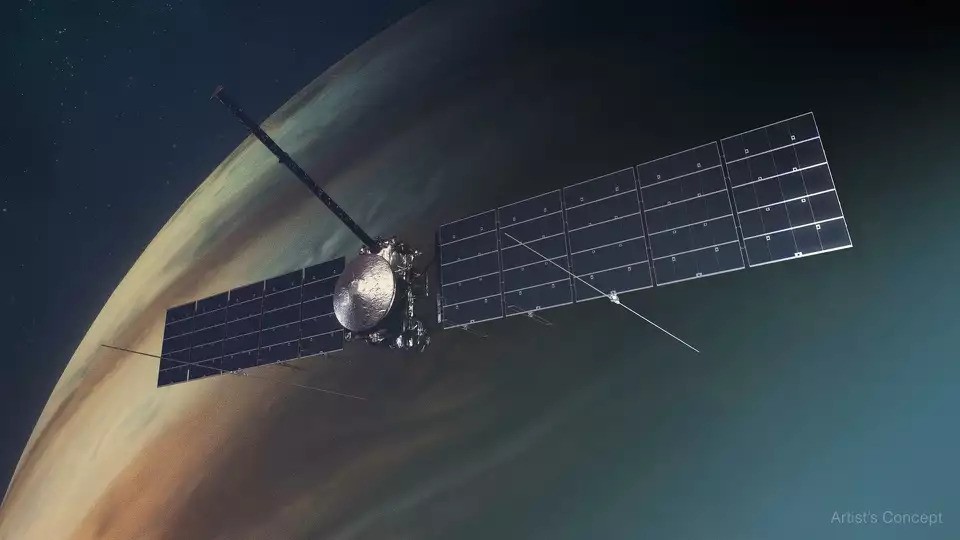NASA’s Bold Voyage: How Will Europa Clipper Transform Our Understanding of Life in Space?
USA NEWS – The Europa Clipper mission has officially launched, marking a significant milestone in NASA’s quest to explore the cosmos. This ambitious project is dedicated to investigating Jupiter’s icy moon, Europa, which scientists consider one of the most promising locations for finding conditions suitable for life beyond Earth. The spacecraft lifted off on Monday afternoon aboard a SpaceX Falcon Heavy rocket, embarking on a six-year journey to uncover the mysteries of this intriguing celestial body. NASA Administrator Bill Nelson expressed excitement, stating, “Today, we embark on a new journey across the solar system in search of the ingredients for life within Jupiter’s icy moon. Our next chapter in space exploration has begun.”
Originally scheduled for launch last Thursday, the mission faced delays due to Hurricane Milton, which swept through Florida. As a precaution, NASA and SpaceX secured the Europa Clipper in a hangar at Kennedy Space Center. Following the storm, teams inspected the launch site at Cape Canaveral and were ultimately given the green light to proceed. With improved weather conditions on Monday, the launch proceeded smoothly, allowing this $5 billion flagship mission to finally take flight after years of planning and development. The anticipation surrounding the launch reflects the immense interest in Europa’s potential as a habitat for life.
The Europa Clipper blasted off from Launch Complex 39A at Kennedy Space Center at precisely 12:06 p.m. EDT. Before liftoff, the spacecraft was encased in a protective payload fairing, designed to shield it from the aerodynamic forces and intense heat of the launch. Engineers from NASA’s Jet Propulsion Laboratory in Southern California meticulously designed the spacecraft to endure the rigors of launch and the harsh conditions of deep space. Powered by 27 Merlin engines, the Falcon Heavy rocket generated over 5 million pounds of thrust, propelling the Clipper through the atmosphere and toward its target.
Once it separated from the rocket’s second stage, the Europa Clipper successfully established communication with mission control, confirming its operational health. The spacecraft then deployed its large solar arrays, essential for powering its instruments during the long voyage ahead. To reach Europa, the Clipper will travel approximately 1.8 billion miles, utilizing gravity assists from Earth and Mars to gain speed along its trajectory. Scheduled to enter Jupiter’s orbit in April 2030, the spacecraft is set to spend the next four years mapping and studying Europa’s surface and subsurface features.
Europa, the fourth largest of Jupiter’s 95 moons, has long captured the attention of scientists due to its potential to harbor conditions conducive to life. Beneath its icy exterior lies a vast salty ocean, which may reach depths of up to 100 miles—twice that of Earth’s oceans combined. The best evidence for this subsurface ocean was provided by NASA’s Galileo spacecraft, which orbited Jupiter from 1995 to 2003. The Europa Clipper aims to build on these findings, searching for organic compounds and energy sources that could indicate the moon’s habitability.
Despite previous missions that have explored Europa, including six spacecraft that have imaged the moon, the Clipper is uniquely equipped to conduct in-depth investigations. One of its primary goals is to assess whether the necessary life-supporting conditions are present beneath Europa’s icy shell. While the mission will not directly seek out life forms, it will focus on identifying the environmental factors that could support life. NASA scientists are particularly interested in how the moon maintains a liquid ocean beneath its frigid surface, a phenomenon attributed to tidal flexing caused by Jupiter’s powerful gravitational forces. This interaction generates enough heat to keep the ocean from freezing solid, allowing for the possibility of life.
As the Europa Clipper embarks on this groundbreaking mission, the scientific community is poised to gain invaluable insights into one of the solar system’s most enigmatic moons. The findings from this mission could significantly enhance our understanding of ocean worlds, both within our solar system and beyond. By studying Europa, NASA hopes to uncover crucial clues about the potential for life elsewhere in the universe, and the Europa Clipper is set to play a pivotal role in this quest. With the launch now successful, the journey toward unraveling the secrets of Europa has officially begun, igniting excitement and curiosity about what lies beneath its icy surface.



